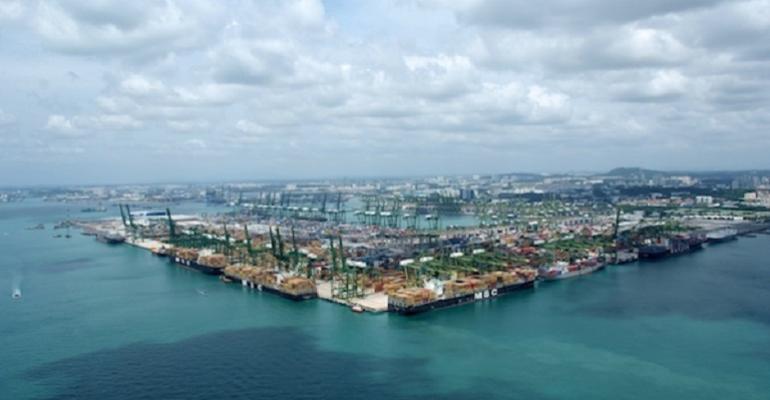Fluctuating services configurations has seen congestion building at some ports as a combination of unexpected events and higher volumes increases pressure on infrastructure and the inland operations whose ability to cope with changeable volumes is causing backlogs and congestion in certain regions.
Drewry Shipping Consultants’ ports expert Eleanor Hadland told Seatrade Maritime News: “We are seeing some congestion hotspots emerging, and Red Sea diversions are a contributory factor. Overall, off-window arrivals have an adverse impact on terminal performance.”
Related: Maersk to continue avoiding Red Sea for the foreseeable future
According to Hadland the worst impacted markets are seeing fewer mainline calls – but each call is taking longer – which indicates a higher cargo exchange – this arises as carriers consolidate cargo to/from specific markets onto fewer services.
“For example, whereas Asia-ME cargo may previously have been handled on a wayport basis (i.e. dropped off / collected at key hubs on Asia-Europe trade) this is now being consolidated onto specific Asia-Middle East routes leading to larger parcel sizes being handled at the main ports,” explained Hadland.
Related: Menace on the Red Sea – MSC rewires entire global network
As a result, the dwell time at Jebel Ali for ships larger than 12,500 teu has increased from around 1.5 days in Q4 2023 to 2.5 days in Q1 2024. But Hadland adds that it is not just the size of the ships that is the problem, holidays such as Eid al-Fitr and Ramadan, as well as the recent Dubai floods have added to the congestion levels too.
Hadland also points to the volume of cargo being discharged which is challenging inland port infrastructure, including the trucking necessary to cope with increased freight and the storage of containers.
A DP World spokeswoman confirmed the challenges facing the port: “Jebel Ali Port has experienced a temporary increase in vessel arrivals due to recent severe weather and changes to regional shipping routes. We’re working diligently with our partners to ensure efficient operations and minimise any effects on schedules. All major shipping lines continue their on-time arrivals at Jebel Ali Port.”
Jebel Ali is not the only facility to suffer congestion challenges with consultancy Linerlytica pointing to Southeast Asian ports, including Singapore and Port Klang recording increased vessel waiting times in the last two weeks.
The Indian Subcontinent/Middle East and Southeast Asia regions account for 15% and 16% respectively of total global port congestion, said Linerlytica.
Dynamar analyst Darron Wadey confirmed the trend saying that there is plenty of anecdotal evidence of regional congestion.
“In fact, it appears to be widespread with ports east of Suez, as far as Ningbo, Shanghai, Singapore, Port Klang and Dubai, for example. It has already been more noticeable for the year-to-date, but seemed to have been easing as May approached,” he added.
MDS Transmodal looked at the number of vessels operating in the Asia to Europe trades and their sizes. According to MDS the number of vessels arriving in the Middle East from southeast Asia stayed fairly stable between Q2 last year and Q1 2024. But in Q2 this year the number of ships handled by Singapore on the Asia to Europe trades increased from around 160 in Q1 to about 260 in Q2 said MDS analyst Antonella Teodoro.

At Port Klang the fluctuating capacity levels were even more volatile. In Q2 2023 just under 30 ships called at the Malaysian facility, by Q1 this year that number had collapsed to around five vessels but shot up again in Q2 to 50 ships.

Cargo capacity from Asia to Europe increased between Q2 2023 and Q1 2024, rising from over 3.5 million teu to 4.5 million teu in Q2 on the major trade lane. However, capacity between the Gulf and Indian Subcontinent to Asia, a substantially smaller trade overall, increased by around 200,000 teu in the same period.
But for Asia to Europe services with wayport calls the capacity increased by about 400,000 teu to 3 million teu, in Q2 this year, but then nosedived more than 30% to a little under 2 million teu.
Hadland said these changes were constant and were having an impact on ports receiving cargo. In particular she said that the Red Sea diversions are still in transition. Initially, vessels heading to the Mediterranean were loaded so that East Med cargo was discharged first, that meant that ships diverting around the cape entered the Med and sailed east before discharging freight.
“Now they’re loading west to east,” said Hadland, “There have been a number of spikes and recoveries, fewer calls [in some places], bigger exchanges which have raised route peaking factors and extended average dwell times. There have been a lot of changes and the ports are supposed to cope with that.”
Hadland said that the effects of these changes had so far not been felt in North European and Mediterranean ports, which had so far escaped the build-up of congestion.
Dynamar’s Wadey, however, agreed with Drewry that the emerging situation had “echoes of the pandemic”.
Vessel reconfigurations also have “logistical implications, not the least of these is that the cargo is not where it was intended to be and will require extra effort to get it where it has to go,” meaning that empty containers are in the wrong place.
Effectively the fear is that the emergent congestion in Asia will eventually arrive in European ports too.
“The capacity deployed, the much larger vessels and more of them means that the lines want those vessels to return to Asia more quickly, adding to the pressure on hub ports in particular. Using these hub ports with more intensity will require more feeder vessels and is expected to eventually bring congestion to Europe too,” explained Teodoro.
Reference: https://www.seatrade-maritime.com/containers/red-sea-rerouting-causing-asian-port-congestion

